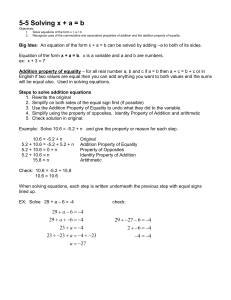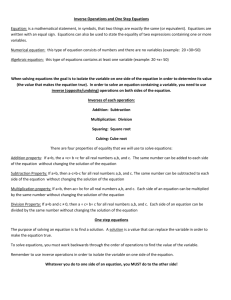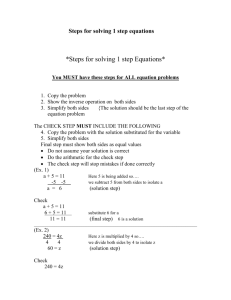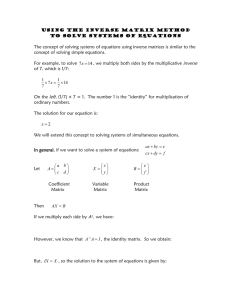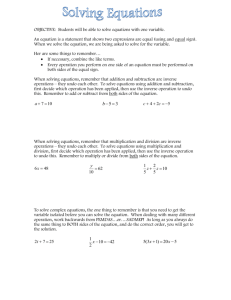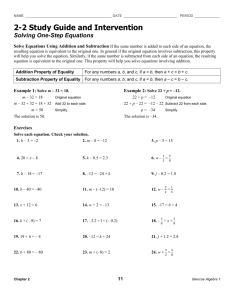5.4 Solving Equations Using the Addition Property of Equality
advertisement
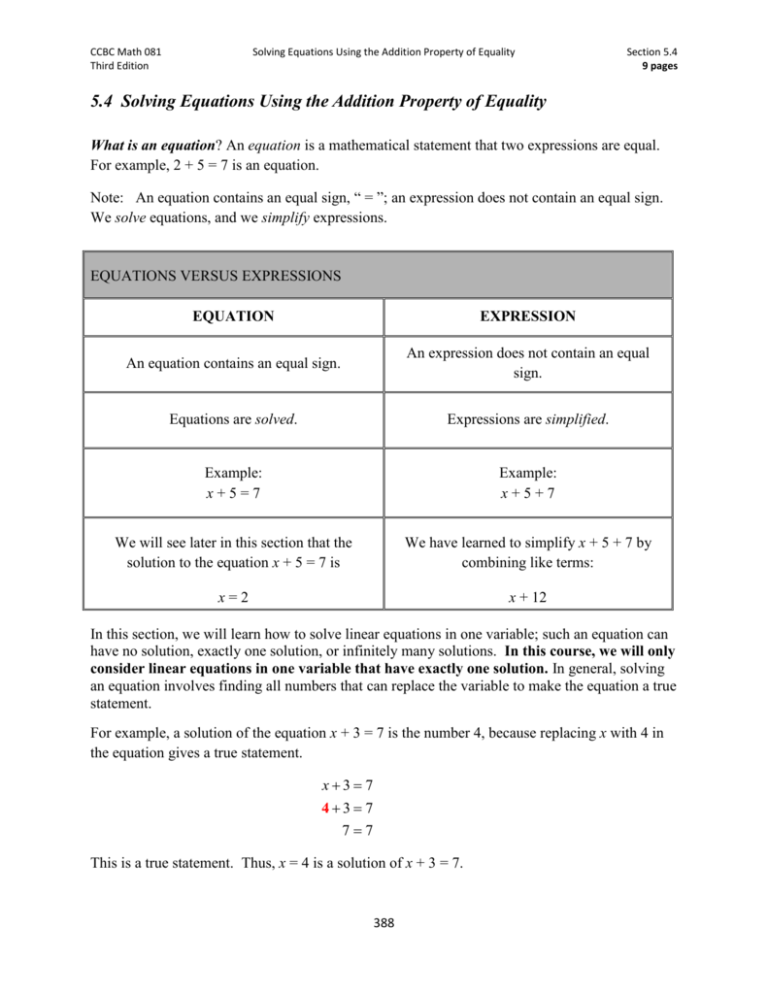
CCBC Math 081 Third Edition Solving Equations Using the Addition Property of Equality Section 5.4 9 pages 5.4 Solving Equations Using the Addition Property of Equality What is an equation? An equation is a mathematical statement that two expressions are equal. For example, 2 + 5 = 7 is an equation. Note: An equation contains an equal sign, “ = ”; an expression does not contain an equal sign. We solve equations, and we simplify expressions. EQUATIONS VERSUS EXPRESSIONS EQUATION EXPRESSION An equation contains an equal sign. An expression does not contain an equal sign. Equations are solved. Expressions are simplified. Example: x+5=7 Example: x+5+7 We will see later in this section that the solution to the equation x + 5 = 7 is We have learned to simplify x + 5 + 7 by combining like terms: x=2 x + 12 In this section, we will learn how to solve linear equations in one variable; such an equation can have no solution, exactly one solution, or infinitely many solutions. In this course, we will only consider linear equations in one variable that have exactly one solution. In general, solving an equation involves finding all numbers that can replace the variable to make the equation a true statement. For example, a solution of the equation x + 3 = 7 is the number 4, because replacing x with 4 in the equation gives a true statement. x3 7 43 7 77 This is a true statement. Thus, x = 4 is a solution of x + 3 = 7. 388 CCBC Math 081 Third Edition Example 1: Solving Equations Using the Addition Property of Equality Section 5.4 9 pages Is x = 11 a solution of the equation x – 8 = 3? Let’s think about this problem first. If we say 11 in the place of x, we would read “eleven minus 8” on the left side of the equation. Does 11 minus 8 equal 3? Yes. Now let’s do this algebraically. Remember, a solution of an equation is a number that when used in place of the variable makes the equation a true statement. To see if 11 is a solution of x – 8 = 3, we replace x with 11 in the equation and see if the result is a true statement. x 8 3 11 8 3 33 This is a true statement. Thus, x = 11 is the solution of x – 8 = 3. Practice 1: Is y = 7 the solution to the equation y – 3 = 4? Watch It: http://youtu.be/h87w5JsLsD8 Example 2: Is a = -7 a solution of the equation a – 4 = -12? Answer: true Let’s think about this problem first. If we replace a with -7, we would read the left side of the equation as “Negative seven minus 4.” What does -7 – 4 equal? Remembering the rules for signed numbers we get -11. This does not equal the right side of the equation. Therefore, -7 is not a solution for this equation. Now, let’s use algebra to determine this. To see if -7 is a solution of a – 4 = -12, we replace a with -7 in the equation and see if the result is a true statement. a 4 12 -7 4 12 11 12 This is a false statement. 11 12 . Thus, a = -7 is not the solution of a – 4 = -12. Practice 2: Is c = –9 the solution to the equation c + 3 = –7? Watch It: http://youtu.be/_7lvmEEjfBo Answer: 389 false CCBC Math 081 Third Edition Solving Equations Using the Addition Property of Equality Section 5.4 9 pages Addition Property of Equality We want to develop a process for solving linear equations in one variable. One property needed for solving the equations in this section is called the Addition Property of Equality. Let a, b, and c be expressions representing real numbers. Then, if a = b, then a + c = b + c. This property states that when you add an expression to one side of an equation, you must also add the same expression to the other side of the equation. Adding the same expression to both sides of an equation will produce an equivalent equation. Therefore, adding the same expression to both sides of an equation will not change the equation’s solution. ADDITION PROPERTY OF EQUALITY WORDS SYMBOLS Adding the same expression to both sides of an equation will produce an equivalent equation. If a = b, then a+c=b+c Additive Inverse Recall the Inverse Property of Addition that we studied in a previous section. INVERSE PROPERTY OF ADDITION WORDS SYMBOLS The sum of a number and its opposite is 0. a ( a ) 0 The sum of a term and its opposite is 0. EXAMPLE 4 (4) 0 2x + (-2x) = 0 Additive Inverse: The additive inverse of a is -a. Similarly, the additive inverse of -a is a. We can say that -a is the opposite of a. We also say that the inverse operation of addition is subtraction and the inversion operation of subtraction is addition. Note: When two opposites are added together the answer is 0. 390 CCBC Math 081 Third Edition Example 3: Solving Equations Using the Addition Property of Equality Section 5.4 9 pages Solve p – 1 = 5. Then, check the solution. Let’s try to do this by thinking about what the equation says. “What number minus 1 is equal to 5?” The answer is 6. Now, we will learn how to solve this equation algebraically. To solve the equation means to determine the value of the variable that makes the equation a true statement. To do this, we want to get the variable on one side of the equation by itself; we call this isolating the variable. On the left side of the equal sign, 1 is subtracted from p. To isolate p, we perform the inverse operation; the inverse of subtraction is addition. Thus, we add 1 to each side of the equation. p 1 5 p 1 +1 5 +1 p06 Use the Addition Property of Equality. Add 1 to both sides of the equation. Simplify. p6 Typically, we do not write the third step: p + 0 = 6. However, even if unwritten, we are using the idea of the additive identity: adding a number and 0 (p + 0 in this problem) produces p, thereby isolating the variable. Check: Substitute 6 for p in the original equation. p 1 5 6 1 5 55 This is a true statement. Thus, p = 6 is a solution for the equation p – 1 = 5. Practice 3: Solve h + 8 = 2. Then, check the solution. Watch It: http://youtu.be/N7NYs4j6htE Answer: 391 h = -6 CCBC Math 081 Third Edition Example 4: Solving Equations Using the Addition Property of Equality Section 5.4 9 pages Solve –9 = m – 4. Then, check the solution. First, let’s try to do this by thinking about what the equation says. “Negative nine equals what number minus 4?” This one is a little tricky, but if we remember our rules for signed numbers we would see that the answer is -5. Now, let’s use algebra to isolate the variable to solve this equation. On the right side of the equal sign, 4 is subtracted from m. To isolate m, we perform the inverse operation; the inverse of subtraction is addition. Thus, we add 4 to each side of the equation. 9 m 4 9 + 4 m 4 + 4 5 m 0 Use the Addition Property of Equality. Add 4 to both sides of the equation. Simplify. 5 m Typically, we do not write the third step: -5 = m + 0. However, even when it is unwritten, we are using the idea of the additive identity: adding a number and 0 (m + 0 in this problem) produces m, thereby isolating the variable. Check: Substitute -5 for m in the original equation. 9 m 4 9 -5 4 9 9 This is a true statement. Therefore, m = -5 is the solution of –9 = m – 4. Practice 4: Solve –8 = w – 1. Then, check the solution. Watch It: http://youtu.be/QUiYkB1XT8w Answer: w = -7 Example 5: Solve x + 2.6 = 4. Then, check the solution. On the left side of the equal sign, 2.6 is added to x. To isolate x, we perform the inverse operation; the inverse of addition is subtraction. Thus, we subtract 2.6 from each side of the equation. x 2.6 4 x 2.6 - 2.6 4 - 2.6 x 0 1.4 Subtract 2.6 from both sides of the equation. Simplify. x 1.4 392 CCBC Math 081 Third Edition Solving Equations Using the Addition Property of Equality Section 5.4 9 pages Check: Substitute 1.4 for x in the original equation. x 2.6 4 1.4 2.6 4 44 This is a true statement. Therefore, x = 1.4 is the solution of x 2.6 4 . Practice 5: Solve c + 5.6 = 9. Then, check the solution. Watch It: http://youtu.be/jYr0ZdTS6fo Answer: c = 3.4 3 2 . Then, check the solution. 10 5 3 On the left side of the equal sign, is subtracted from h. To isolate h, we perform the inverse 10 3 operation; the inverse of subtraction is addition. Thus, we add to each side of the equation. 10 3 2 h 10 5 3 3 3 2 3 Add to both sides of the equation. h + + 10 10 10 5 10 4 3 Write fractions with a common denominator. h0 10 10 7 Add numerators to simplify. h 10 Example 6: Solve h 7 for h in the original equation. 10 3 2 h 10 5 7 3 2 10 10 5 4 2 10 5 2 2 5 5 7 3 2 This is a true statement. Therefore, h is the solution of h . 10 10 5 Check: Substitute 393 CCBC Math 081 Third Edition Solving Equations Using the Addition Property of Equality Section 5.4 9 pages 8 1 . Then, check the solution. 9 3 Practice 6: Solve x Watch It: http://youtu.be/qAZguAAAC0g Answer: Watch All: http://youtu.be/GI4XGGidadQ 394 x 11 9 CCBC Math 081 Third Edition Solving Equations Using the Addition Property of Equality 5.4 Solving Equations using the Addition Property Exercises Determine whether the given value is a solution to the equation. 1. 5 = w – 14 w = 19 2. 21 = -3 + z z = 17 3. x – 8 = 10 x = 18 4. 6 = -6 + h h = 12 5. 12 = x + 72 x = 19.2 Solve each equation and check the solution. 6. n – 6 = 13 7. x–3=9 8. a – 3 = -1 9. x – 6 = -8 10. -12 = y – 3 11. a – 2.9 = -3.6 12. -8.3 = p – 5.6 13. 14. 15. 16. b 2 4 3 3 8 d 1 9 5 1 h 8 4 r – 4.2 = 3.5 17. 10 = -7 + x Solve each of the following equations. 18. y+4–6=7–1 19. x – 6 – 2 = 5 – 12 20. 2–6=a–1 395 Section 5.4 9 pages CCBC Math 081 Third Edition Solving Equations Using the Addition Property of Equality 5.4 Solving Equations using the Addition Property Exercises Answers 1. True Statement 2. False Statement 3. True Statement 4. True Statement 5. False Statement 6. n = 19 7. x = 12 8. a=2 9. x = -2 10. y = -9 11. a = -0.7 12. p = -2.7 13. b=2 14. d 15. 1 9 7 h 8 16. r = 7.7 17. x = 17 18. y=8 19. x=1 20. a = -3 396 Section 5.4 9 pages
